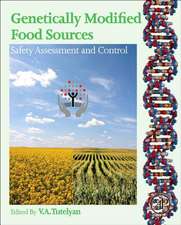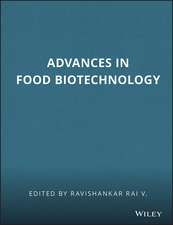Handbook of Food Factory Design
Editat de Christopher G. J. Bakeren Limba Engleză Hardback – 27 aug 2013
| Toate formatele și edițiile | Preț | Express |
|---|---|---|
| Paperback (1) | 1315.35 lei 6-8 săpt. | |
| Springer – 23 aug 2016 | 1315.35 lei 6-8 săpt. | |
| Hardback (1) | 1747.52 lei 6-8 săpt. | |
| Springer – 27 aug 2013 | 1747.52 lei 6-8 săpt. |
Preț: 1747.52 lei
Preț vechi: 2131.11 lei
-18% Nou
Puncte Express: 2621
Preț estimativ în valută:
334.43€ • 347.86$ • 276.09£
334.43€ • 347.86$ • 276.09£
Carte tipărită la comandă
Livrare economică 14-28 aprilie
Preluare comenzi: 021 569.72.76
Specificații
ISBN-13: 9781461474494
ISBN-10: 1461474493
Pagini: 575
Ilustrații: VIII, 504 p. 133 illus., 18 illus. in color.
Dimensiuni: 178 x 254 x 32 mm
Greutate: 10.98 kg
Ediția:2013
Editura: Springer
Colecția Springer
Locul publicării:New York, NY, United States
ISBN-10: 1461474493
Pagini: 575
Ilustrații: VIII, 504 p. 133 illus., 18 illus. in color.
Dimensiuni: 178 x 254 x 32 mm
Greutate: 10.98 kg
Ediția:2013
Editura: Springer
Colecția Springer
Locul publicării:New York, NY, United States
Public țintă
Professional/practitionerCuprins
Introduction.- Part I. Process Considerations.- Process Specifications.- Food Processing Equipment.- Hygienic Design of Food-Processing Equipment.- Movement of Materials.- Productivity Issues: Industrial and Operations Management.- Safety and Health.- Protecting the Environment.- Control and Monitoring of Food Manufacturing Processes.- Use of Computers in the Design of Food-Manufacturing Facilities.- Part II. Factory Infrastructure.- Site Considerations.- Design Principles.- Construction: Techniques and Finishes.- Part III. Utilities and Services.- Steam Systems.- Refrigeration Systems.- Heating, Ventilation and Air Conditioning.- Utilities and Their Conservation.- Effluent Treatment.- Part IV. Project Engineering Management.- Role of the Project Engineer in the Design Stage.- Role of the Project Engineer in the Construction Stage.
Notă biografică
Christopher G. J. Baker is a Chartered Chemical Engineer whose interests range from food process design to industrial drying. He worked in the UK food industry for several years before moving to the Middle East, where he was Professor of Chemical Engineering at Kuwait University. He recently returned to the UK and is currently involved in a number of consultancy assignments.
Textul de pe ultima copertă
Food manufacturing has evolved over the centuries from kitchen industries to modern, sophisticated production operations. A typical food factory includes the food processing and packaging lines, the buildings and exterior landscaping, and the utility-supply and waste-treatment facilities. As a single individual is unlikely to possess all the necessary skills required to facilitate the design, the task will undoubtedly be undertaken by an interdisciplinary team employing a holistic approach based on a knowledge of the natural and biological sciences, most engineering disciplines, and relevant legislation. In addition, every successful project requires a competent project manager to ensure that all tasks are completed on time and within budget.
This Handbook attempts to compress comprehensive, up-to-date coverage of these areas into a single volume. The multi-disciplinary nature of the subject matter should facilitate more informed communication between individual specialists on the team. It should also provide useful background information on food factory design for a wider range of professionals with a more peripheral interest in the subject: for example, process plant suppliers, contractors, HSE specialists, retailers, consultants, and financial institutions. Finally, it is hoped that it will also prove to be a valuable reference for students and instructors in the areas of food technology, chemical engineering, and mechanical engineering, in particular.
Christopher G. J. Baker is a Chartered Chemical Engineer whose interests range from food process design to industrial drying. He worked in the UK food industry for several years before moving to the Middle East, where he was Professor of Chemical Engineering at Kuwait University. He recently returned to the UK and is currently involved in a number of consultancy assignments.
This Handbook attempts to compress comprehensive, up-to-date coverage of these areas into a single volume. The multi-disciplinary nature of the subject matter should facilitate more informed communication between individual specialists on the team. It should also provide useful background information on food factory design for a wider range of professionals with a more peripheral interest in the subject: for example, process plant suppliers, contractors, HSE specialists, retailers, consultants, and financial institutions. Finally, it is hoped that it will also prove to be a valuable reference for students and instructors in the areas of food technology, chemical engineering, and mechanical engineering, in particular.
Christopher G. J. Baker is a Chartered Chemical Engineer whose interests range from food process design to industrial drying. He worked in the UK food industry for several years before moving to the Middle East, where he was Professor of Chemical Engineering at Kuwait University. He recently returned to the UK and is currently involved in a number of consultancy assignments.
Caracteristici
A 'how-to' of food factory design
Multi-disciplinary content aimed at wide range of professionals
Reference guide for both students and instructors
Includes supplementary material: sn.pub/extras
Multi-disciplinary content aimed at wide range of professionals
Reference guide for both students and instructors
Includes supplementary material: sn.pub/extras


















